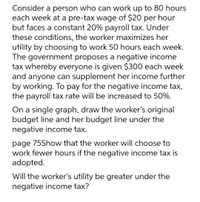
Principles of Economics 2e
2nd Edition
ISBN: 9781947172364
Author: Steven A. Greenlaw; David Shapiro
Publisher: OpenStax
expand_more
expand_more
format_list_bulleted
Concept explainers
Question
E2

Transcribed Image Text:Consider a person who can work up to 80 hours
each week at a pre-tax wage of $20 per hour
but faces a constant 20% payroll tax. Under
these conditions, the worker maximizes her
utility by choosing to work 50 hours each week.
The government proposes a negative income
tax whereby everyone is given $300 each week
and anyone can supplement her income further
by working. To pay for the negative income tax,
the payroll tax rate will be increased to 50%.
On a single graph, draw the worker's original
budget line and her budget line under the
negative income tax.
page 75Show that the worker will choose to
work fewer hours if the negative income tax is
adopted.
Will the worker's utility be greater under the
negative income tax?
Expert Solution
This question has been solved!
Explore an expertly crafted, step-by-step solution for a thorough understanding of key concepts.
This is a popular solution
Trending nowThis is a popular solution!
Step by stepSolved in 4 steps with 2 images

Knowledge Booster
Learn more about
Need a deep-dive on the concept behind this application? Look no further. Learn more about this topic, economics and related others by exploring similar questions and additional content below.Similar questions
- Jonathan is a single father with one child. He can work as a server for $6 per hour for up to 1,500 hours per year. He is eligible for welfare, and so if he does not earn any income, he will receive a total of 10,000 per year. He can work and still receive government benefits, but for every 1 of income, his welfare stipend is 1 less. Create a table similar to Table 15.4 that shows Jonathans options. Use four columns, the first showing number of hours to work, the second showing his earnings from work, the third showing the government benefits he will receive, and the fourth column showing his total income (earnings + government support). Sketch a labor-leisure diagram of Jonathans opportunity set with and without government support.arrow_forwardWhat goods and services would you include in an estimate of the basic necessities for a family of four?arrow_forwardWhich set of policies is more likely to cause a tradeoff between economic output and equality: policies of redistribution policies aimed at the ladder of opportunity? Explain how the production possibility frontier tradeoff between economic equality and output might look in each case.arrow_forward
- Using two demand and supply diagrams, one for the low-wage labor market and one for the high-wage labor market, explain how a program that increased educational levels for a substantial number of low-skill workers could reduce inflame inequality.arrow_forwardUsing two demand and supply diagrams, one for the low-wage labor market and one for the high-wage labor market, explain how information technology can increase income inequality if it is a complement to high-income workers like salespeople and managers, but a substitute for low-come workers like file clerks and telephone receptionists.arrow_forwardWhy is there reluctance on the part of some in the United States to redistribute income so that greater equality can be achieved?arrow_forward
- Who is included in the top income quintile?arrow_forwardDescribe how each of these changes is likely to affect poverty and inequality: Incomes rise for low-income and high-income workers, but rise more for the high-income earners. Incomes fall for low-income and high-income workers, but fall more for high-income earners.arrow_forwardHow is the poverty rate calculated?arrow_forward
- Redistribution of income occurs through the federal income tax and government antipoverty programs. Explain whether or not this level of redistribution is appropriate and whether more redistribution should occur.arrow_forwardExercise 15.2 and Exercise 15.3 asked you to describe the labor-leisure tradeoff for Jonathon. Since, in the first example, there is no monetary incentive for Jonathon to work, explain why he may choose to work anyway. Explain what the opportunity costs of working and not working might be for Jonathon in each example. Using your tables and graphs from Exercise 15.2 and Exercise 15.3, analyze how the government welfare system affects Jonathans incentive to work.arrow_forwardSuppose each family in the United States earned an equal money income. What would be the effect?arrow_forward
arrow_back_ios
SEE MORE QUESTIONS
arrow_forward_ios
Recommended textbooks for you
 Principles of Economics 2eEconomicsISBN:9781947172364Author:Steven A. Greenlaw; David ShapiroPublisher:OpenStax
Principles of Economics 2eEconomicsISBN:9781947172364Author:Steven A. Greenlaw; David ShapiroPublisher:OpenStax Exploring EconomicsEconomicsISBN:9781544336329Author:Robert L. SextonPublisher:SAGE Publications, Inc
Exploring EconomicsEconomicsISBN:9781544336329Author:Robert L. SextonPublisher:SAGE Publications, Inc Microeconomics: Private and Public Choice (MindTa...EconomicsISBN:9781305506893Author:James D. Gwartney, Richard L. Stroup, Russell S. Sobel, David A. MacphersonPublisher:Cengage Learning
Microeconomics: Private and Public Choice (MindTa...EconomicsISBN:9781305506893Author:James D. Gwartney, Richard L. Stroup, Russell S. Sobel, David A. MacphersonPublisher:Cengage Learning Economics: Private and Public Choice (MindTap Cou...EconomicsISBN:9781305506725Author:James D. Gwartney, Richard L. Stroup, Russell S. Sobel, David A. MacphersonPublisher:Cengage Learning
Economics: Private and Public Choice (MindTap Cou...EconomicsISBN:9781305506725Author:James D. Gwartney, Richard L. Stroup, Russell S. Sobel, David A. MacphersonPublisher:Cengage Learning

Principles of Economics 2e
Economics
ISBN:9781947172364
Author:Steven A. Greenlaw; David Shapiro
Publisher:OpenStax

Exploring Economics
Economics
ISBN:9781544336329
Author:Robert L. Sexton
Publisher:SAGE Publications, Inc

Microeconomics: Private and Public Choice (MindTa...
Economics
ISBN:9781305506893
Author:James D. Gwartney, Richard L. Stroup, Russell S. Sobel, David A. Macpherson
Publisher:Cengage Learning

Economics: Private and Public Choice (MindTap Cou...
Economics
ISBN:9781305506725
Author:James D. Gwartney, Richard L. Stroup, Russell S. Sobel, David A. Macpherson
Publisher:Cengage Learning

